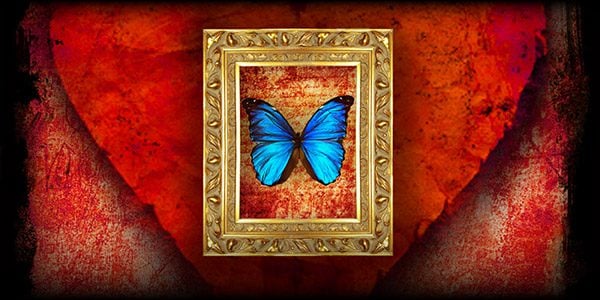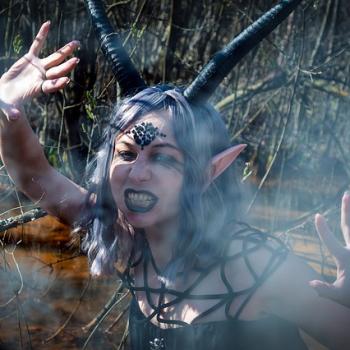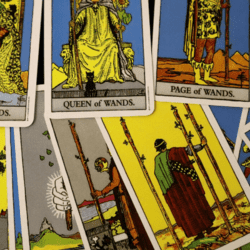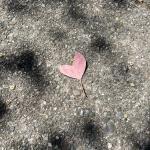The hero is always wounded…has always sustained some traumatic damage in their past that ultimately leads to their final victory. In fact, the hero ultimately cannot overcome the final test without their wounding. It’s sometimes called the Sacred Wound when heroes heal enough to take strength from what he has learned. They succeed in their quest because of their wound.
What wound has the hero endured? What gifts does the hero receive? What abilities does the hero gain so that they can fulfill their destiny?

First, a brief note:
This post was almost lost forever. I originally wrote it for a now-defunct blog, and for a moment, I thought I didn’t have a backup copy. Fortunately I did, but life’s not without a little irony; this is my last post here at Patheos Pagan. It’s entirely possible that all of my posts might get removed at some time in the future. If you want to keep in touch or keep up with my writing, check out www.ShaunaAuraKnight.com or find me on social media. I have a few books about to get released, and I’ve just launched a Patreon, and contributors will get early looks at articles, artwork and book chapters, among other perks like chants, downloadable artwork, and more. Now, back to the article.
Wound and Psychology
The wound causes scar tissue, it’s just that it’s invisible psychological scar tissue. The wound usually causes maladaptive psychological strategies that we use to cope with what’s happened. They help us survive, like crutches, but they can cause pain long after the wounding is done.
There is a moment when we recognize that our coping mechanism is actually holding us back; after this, we can begin to transform ourselves. That’s the moment we can look at our wound and what was done to us, what we did to cope with it, and choose whether or not that behavior is useful going forward. When we look at the coping strategies we no longer need, we can harvest the strength from them. They leave us gifts. That is, if we can dig down and look for them. If we are willing to heal from the wound, if we are willing to let go of the role of victim. We (mostly) don’t choose to be hurt. But we can choose how we act going forward.
For instance, Harry Potter lets go of his rebellious standoffishness and opens himself to connection with friends and mentors.
Case Study: Harry Potter
He bears the lightning scar on his forehead, the magical souvenir from when Voldemort murdered his parents and tried to murder him. An orphan, he grows up feeling very alone; he lives under the stairs, emotionally abused by his adoptive family. He grows up not trusting anyone, wondering what his parents were like, wishing they’d been there to care for him.
He learns independence, even to the point of being rebellious. This serves him as he begins his quest. Harry finds some healing by connecting to Hagrid, Dumbledore, his friends…and Sirius Black, who becomes a surrogate father. Just as he begins to open up, Sirius is killed. Ultimately, it is healing from his own distrust that is his healing from the wound. The crack he will always have in his heart is his fear of being alone.
However, growing up alone has given him in some ways more capacity to love. Harry doesn’t take people for granted.
When he’s called on, in the end, to give his life—it is the love of those who’ve died, and it’s his love of those who still live. That gives him the strength to lay down his life to save his friends.
Case Study: Luke Skywalker
Luke transforms from whiny farmboy into Jedi badass. He got there through tragedy, death, and pain. Each challenge he went through made him stronger. He couldn’t do what he does in Return of the Jedi–face the Emperor and Darth Vader–without everything he went through.
Like Harry Potter, Luke grew up an orphan raised by relatives. What it does for both Harry Potter and for Luke is give them a sense of yearning. They fantasize about the life they might have had. They feel like something in their life is missing because they don’t have parents. They also both chafe against the constraints placed against them by their adoptive families.
Luke’s greatest strength becomes a weakness that Vader exploits. Vader captures and tortures his friends to lure Luke to Cloud City. Now that he’s found a family of choice in Han, Leia, Chewie, and the Droids, Luke will do anything to save them. His love of his friends is his strength.
Later, Luke would never have been able to turn himself over to the Emperor on the Death Star without that depth of love. He doesn’t take people for granted. Having grown up without parents, and having wished for that closeness, he knows the consequences of loss. That’s reinforced when he loses his aunt and uncle; though their relationship was tense, they were still his family. He loses Obi Wan Kenobi. He loses Biggs. Almost lost Han. Luke isn’t going to lose anyone else.
But that love is his weakness too. Yoda and Obi Wan caution him that his feelings can be used against him. Indeed, his own father Anakin was turned to the Dark Side because of love that led to fear.
Without that depth of love, without knowing the consequences of loss, Luke wouldn’t be able to be the guy who goes into the lion’s den on the Death Star to distract the Emperor. Luke is even unwilling to sacrifice his father. His vengeful, acting-out-of-his-own-wounds father who cuts Luke’s hand off and killed so many. He saves him and returns Vader to being Anakin.
It took the whole journey–and the pain–to become the strong Jedi who could do that. Luke is terrified of loss, terrified of becoming like Vader. Luke had to lose his home, his aunt and uncle, his mentor Ben, and others to propel him to seek training as a Jedi. He’d never have stuck with Yoda’s prodding and cackling without all of that.
It’s in the Cave that Luke sees one of his worst fears–that he will become Vader. Yoda told Luke that he won’t need his weapons in the cave. Our own fears are what we bring with us. Only later, Luke learns the truth of it; that the father he’s been seeking all his life is actually the masked monster who has been torturing people to get at him.
Luke tries to fight anger with anger, he’s cocky, and he loses his hand. This is the turning point for Luke. It’s where he gets the most obvious external wound marking reflecting the major shift in his character. You can’t suffer a blow like that and not change. In Luke’s case, it gives him focus. He becomes stronger, calmer, and in the end, he saves the man who did it to him, helps Anakin redeem himself.
If Luke hadn’t released his anger around his wounds, if he’d become just a bitter victim, he’d never have saved Anakin or helped destroy the Death Star.
Lord of the Rings: Frodo
Frodo starts life out with a little less angst than Luke or Harry, but he catches up when he’s forced out of his comfy Hobbit-hole and harried across Middle Earth, then stabbed by the Ringwraith. His wound heals up, but never ceases causing him pain. I think that is the moment where Frodo learns how serious the quest is and the consequences if he doesn’t act. Gandalf dying drives it further home. When Boromir gets seduced by the ring, Frodo learns even further pain; he can’t even trust the Fellowship. Without Gandalf there to guide him, he grows up fast. He decides to go to Mordor alone, finds the strength to journey forth into an unknown land.
Certainly he must expect that he will not return from this journey. He does it to save everyone from the Ring.
It’s in Mordor that Frodo sees Gollum, his spindly-legged greatest fear. If Frodo gives in to the Ring, he’ll become Gollum just as Smeagol did. However, like Luke, Frodo’s convinced that he can redeem Gollum. Frodo cares. He believes that the world can be better, else he wouldn’t be sacrificing his life to destroying the Ring. The same caring that leads him to try and help Gollum.
Frodo’s shadows and old wounds get the better of him at the end. He gets 99% of the way there and the Ring turns him. Ironically, if it weren’t for Gollum staying true to his own dark side, the Ring probably wouldn’t have gotten destroyed. However–staying on the topic of recovering from Old Wounds–Frodo gets 99% of the way there because of his tenacity, his love. If he’d gotten stabbed and run away crying, none of that would have ever happened. His wound made him stronger.
King Arthur
Let’s take a brief spin to a far older, but still popular, story. Arthur grows up in the household of his foster-father and foster-brother sir Kay. Sound familiar? He has a home, but without his own noble lineage, Arthur can’t become a knight. He’s a good boy who makes mistakes, and he suffers some abuse at the hand of Kay and others in the household.
Sounding familiar again?
Merlin (Obi Wan? Gandalf? Dumbledore?) guides him, but ultimately his destiny unfolds when he pulls the sword from the stone. Arthur becomes a good king. Because of his upbringing, he knows the consequences of failure at a level that other nobles don’t. He knows that it’s the lower classes that suffer the most. He goes on to be a strong leader, though he’s beset by betrayals from Gwenivere, Lancelot, Morgana, and Mordred. In the movie Excalibur, Arthur is the king who suffers the wound that blights the land, causing the knights to go out on the Grail Quest. Typically, Arthur’s wound isn’t as visible as Harry’s scar or Luke’s hand. His wound is similar to theirs, in that he has suffered loss and hardship, and so understands the consequences.
Arthur could have stayed a whiny squire, or become a bitter king. Instead, he took the hits, saw how people acted toward each other, and used that to build a stronger kingdom and a more just, fair system for everyone, not just for the elite.
In the Grail version of the story, Arthur has to be healed of his wound before the land can flower again. And that is true of each of us as well; we must heal of our old wounds to bring the waters back to the wasteland. To bring life and life force back into our lives.
Releasing Old Wounds
This is some of the hardest work out there. Most of us don’t have swords, horses, magic powers, lightsabers, space ships, or massive scars that highlight where we fought the Dark Knight, where we wrestled with dark nights of our souls. But we do have wounds.
And those wounds hold us back. Or rather–our maladaptive responses to those wounds can hold us back.
It’s not until we really look at ourselves, at our lives, look at what was done to us–look at our scar tissue and response to the wound–that we can choose how we want to act. When we consciously choose, we have the capacity to become the heroes in our own lives.
My Old Wound
Here’s one of mine. I was verbally and emotionally abused by my peers as a kid/teen. I developed a tough outer shell. I withdrew. I read books, I painted, I wrote stories. I learned to be strong, independent. I learned to control my emotions; kids would tease me, and I protected by showing no emotion; I learned to stop feeling, learned to dissociate from my feelings.
How this harmed me:
My maladaptive strategy was that I became too strong, too cold. I pushed people away. I was so used to being rejected by everyone that I learned to pre-reject myself. I was better than them, smarter, right? I didn’t need them. I coped with years of rejection by surrounding myself in the fantasy that everyone else was flawed and I was somehow better than everyone.
In my teen years, this literally kept me from ending my life. I couldn’t actually cope with so much rejection and abuse, all I could do was create a bubble. However once I was away from the bullies, I still acted like everyone around me was my enemy.
I recall whining a lot in my early 20’s. “Nobody loves me, nobody understands me, I’m going to be alone forever.” It wasn’t until I began working with the concept of old wounds that I understood the horrible, dark truth:
I was making that happen.
In pre-rejecting people, in being cold and strong, in being in my “better than you” bubble, I was continuing to make it happen. By being unwilling to talk to people, to take a risk and ask if they wanted to be friends and instead hanging out on the fringes of the group with my arms folded, I was making it happen. By being too shy to speak to people, watching people from the fringes, sneering inside at them, I was making it happen.
The Old Wound never goes away. There are always scars. Being lonely is one of my greatest fears. But, in opening up, in connecting to others, I found out that other people do understand me, and like me. I couldn’t have found that out without healing, without taking a risk.
This old wound has given me power, too; I see it when someone else is eaten alive by that wound of crippling loneliness, or rejecting and lashing out at others because they were rejected. Sometimes I can help folks like that.
This wound gave me a lot of gifts. I had a depth of maturity early on; I wrote entire novels in my teens, created and sold my own artwork. I became strong, independent, resourceful.
I’m also ridiculously good in a crisis. The ability to shut off my emotions to cope with bullying is useful when I’m running an event. I’ve put out a fire without it raising my pulse, dealt with injuries, rowdy people, no-show presenters, other event catastrophes. Once I was driving to an event to facilitate the main ritual, and my car’s brakes went out on the highway. I don’t think that I even felt anything (emotionally), I just went into strategy mode and got the car off the highway.
Are you the Hero?
The wounding is necessary for the hero to gain the skills to complete their task. While we may or may not have swords or go on epic journeys–we are heroes too.
Jean Houston says “The wounding becomes sacred when we are willing to release our old stories and to become the vehicles through which the new story may emerge into time. When we fail to do this, we repeat the same old story over and over again.” There are exercises in Jean Houston’s book The Search for the Beloved that you can use to explore personal transformation around your old wounds.
What would your life look like if you weren’t on autopilot? What would you life look like if you didn’t let the past hurts keep you trapped in the past? Are there old stories you hold about yourself and others that are keeping you in a rut, replaying the same story over and over? Is it a story you’d like to change?
How would your life be different, how would your life be better, if you released the Old Wound, took away its power over you?
Would you, too, become the hero?

Patheos Pagan on Facebook.

the Agora on Facebook
Seeking the Grail is published on monthly on the third Monday. Subscribe via RSS or e-mail!
Please use the links to the right to keep on top of activities here on the Agora as well as across the entire Patheos Pagan channel.

















